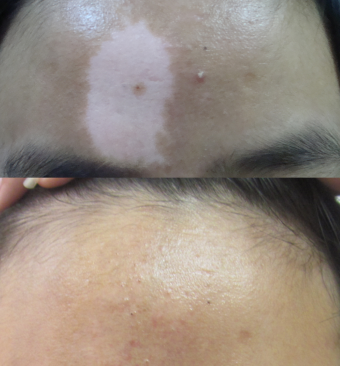What is the operative therapy of vitiligo?
What is the operative therapy of vitiligo?

Surgical treatment may be considered for patients with vitiligo after all non-traumatic treatment therapies have failed. Surgical treatment is time-consuming and usually suitable for stable patients, especially for localized and segmental type. Other types of vitiligo lesions can also be used. The position and size of vitiligo should be considered in treatment. Patients with evolution period and cicatricial corporeity are contraindications for grafting.
Tissue grafting
Tissue grafting involves grafting of Autologous cultured melanocytes, Tiny skin grafting and Split-thickness skin grafting in which a normal piece of skin is removed from a healthy area of the patient's body and grafted into the white patch. This type of skin grafting is mainly used in patients with vitiligo who do not have a large area with white patch.
Cell grafting
Cell grafting can be divided into Autologous cultured melanocyte grafting and Autologous non-cultured epidermal cell suspension grafting for large area of skin lesions.
1. Autologous melanocyte grafting is a procedure in which doctors take a sample of the patient's normal skin pigment and place it in a culture specifically designed to grow melanocytes. When the amount of melanocytes in the culture multiplies, doctors transplants them into the area where the patient had lost pigment.
The procedure is complex, including cell suspension, culture and grafting. The time is usually long in vitro culture, high requirements for culture environment are needed, and cells are of easy pollution, so the higher requirements for professionalism is needed, the whole practical is with relatively high cost.
2. Autologous non-cultured epidermal cell suspension grafting.
- Suspension grafting of epidermal melanocytes and keratinocytes.
- Grafting of hair follicle outer root sheath cell suspension.
- Mixed suspension grafting of epidermis and hair follicle cells.
This method can increase the recipient area to 80 times the donor area, which is similar to the effect of skin graft. The operative effect was related to the type of vitiligo, whether combined with phototherapy or not, the follow-up period, the number of operations and the ratio of donor area. If the therapeutic effect is not satisfactory after surgery, multiple operations are needed.
Other surgical methods.
1. Single-plant hair follicle grafting
Single-plant hair follicle grafting is to implant hair follicle units from normal parts (mainly occipital part) into the skin lesions, and to supplement normal melanocytes through reverse migration of stem cells in the hair follicle to promote the recovery of color, which is suitable for skin lesions with white hair. However, the operation is complicated and scar is easy to form.
2. Combination of Subdermal injection of platelet-rich plasma and narrow-spectrum UVB phototherapy
The effect of subdermal injection of platelet-rich plasma combined with narrow-spectrum UVB phototherapy is better than phototherapy alone, which may be related to the effect of various growth factors on melanocytes in platelet-rich plasma, and can be used as a therapeutic means.



Leave a Comment